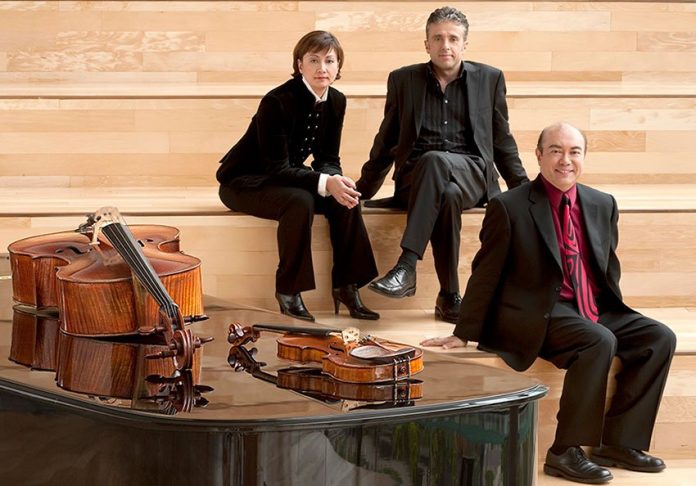Camden Shaw, the cellist for the Dover Quartet, had just arrived at an airport in Arkansas, en route from London, when he called my home phone.
The Dover, one of classical music’s most-coveted ensembles – “the young string quartet of the moment,” in the words of The New Yorker – was fresh from performing at London’s Wigmore Hall with piano legend Emanuel Ax, and Shaw had perhaps a half hour to talk before being whisked away to the Dover’s next engagement.
Ever since sweeping the 2013 Banff Competition, winning every prize in every category, the Dover have been international stars, with more offers to perform than the four young musicians can possibly fulfill.
On August 9 and 10, the Dover Quartet will make its second appearance in two years at the Festival de Música de Cámara de San Miguel de Allende, which runs this season from August 2 to August 31.
Shaw did not have to stop to think when I asked him why the San Miguel festival is so appealing to the Dover. First, there is the city itself, one of the world’s highest-rated tourist destinations.

Then there is the performance space, Teatro Ángela Peralta, the warm and inviting concert hall in the heart of downtown San Miguel, a neoclassical 19th-century opera house with a facade of rose-colored sandstone.
Most particularly, Shaw likes the San Miguel festival’s atypical format, established over four decades. (Inaugurated in June 1979, the festival is entering its 41st consecutive season.) Many other chamber festivals dictate programs to the performers, asking the ensembles to play predetermined pieces with resident musicians.
The San Miguel festival, by contrast, invites chamber ensembles to come with repertoire of their own choosing, and present two different back-to-back concerts on consecutive Friday and Saturday evenings.
“The San Miguel format is wonderful,” Shaw says. “It’s like a mini-residency.”
It is wonderful for audiences, too. Concert-goers are able to experience the undiluted essence of some of classical music’s finest ensembles, playing the pieces for which they have the greatest affinity.
A case in point is the program chosen by the Gryphon Trio, widely acknowledged as the premier piano trio ensemble in Canada. The Gryphon’s two concerts are scheduled for August 16 and 17, and comprise a total of six works.

Three of those pieces are Beethoven, Brahms and Schubert warhorses, but the other three are compositions with which the Gryphon has a special relationship. First, there is Joseph Haydn’s Keyboard Trio No. 19 in G minor.
Though the Haydn trios contain “some of the greatest music ever written” (Charles Rosen, The Classical Style), they are woefully underperformed because in Haydn’s day the piano trio was essentially a piano showcase, with few independent melodic passages for violin and cello. By putting ego considerations aside, the Gryphon have become nonpareil interpreters of Haydn.
The Gryphon have also programmed Rebecca Clarke’s long-neglected Piano Trio, composed in 1921, and Love Triangle, by the Sri Lankan-born Canadian composer Dinuk Wijeratne. Commissioned by the Gryphon in 2013, Love Triangle fuses Western classical structure with Middle Eastern and North Indian modes and rhythms.
The composition includes cadenzas for each instrument, aiming for an effect that Wijeratne calls “the glorious out-of-time-ness” that occurs when an Arabic oud solos over the steady groove of a band.
The composer told me the improbable story of how he was commissioned to write Love Triangle. In 2007, in Nova Scotia, he had conducted Ravel’s Piano Concerto in G Major with Gryphon pianist Jamie Parker as the soloist.
Half a dozen years later, on a whim, Wijeratne reached out to Parker via Facebook Messenger. “I said, ‘I don’t think you know this, but I am a composer, too.’” Two weeks later, he received a commission. The Gryphon have since performed Love Triangle over a hundred times. “The piece usually goes down well with audiences,” Wijeratne told me.
The San Miguel festival’s two other visiting ensembles for 2019 represent the same level of excellence as the Dover and Gryphon. The opening concerts, on August 2 and 3, feature the Cuarteto Latinamericano, two-time Grammy winners, called “superb” by the New York Times, appearing with musical guests Sivan Rotem, soprano, and Nargiza Kamilova, piano.
Performing as a chamber ensemble and an orchestra, the Symphonie Atlantique of the Hague, Netherlands, will close the festival. The chamber group will present a collection of baroque and classical works on August 23 and 24, respectively, on instruments such as baroque bassoon, viola de gamba and harpsichord. The full orchestra will perform at the Peralta on August 30 in a program that includes the Mendelssohn Violin Concerto in E minor.
Finally, the Symphony Atlantique will be featured in two special events. On August 21, at 7:30pm, at the new Auditorio Renacimiento in León, Guanajuato, student musicians will join forces with the Symphony Atlantique in a concert of baroque works.
And on August 31, the Symphony Atlantique will perform at the Hacienda Santa Clara in San Miguel in a gala closing night celebration.
All nine Peralta concerts are at 7:00pm. Tickets range in price from 725 to 150 pesos, and may be purchased online at boletocity.com, or at the Boleto City ticket kiosk in the Mercado Sano, Ancha de San Antonio 123, San Miguel de Allende, every day but Sunday between 11:00am and 5:00pm.
Ticket purchases help support the festival’s education program for Mexican music students. For more information about the festival, visit FestivalSanMiguel.com.
Fredric Dannen is a New York Times bestselling author, and a former staff writer for Vanity Fair and The New Yorker. He has been a San Miguel resident since 2002.
